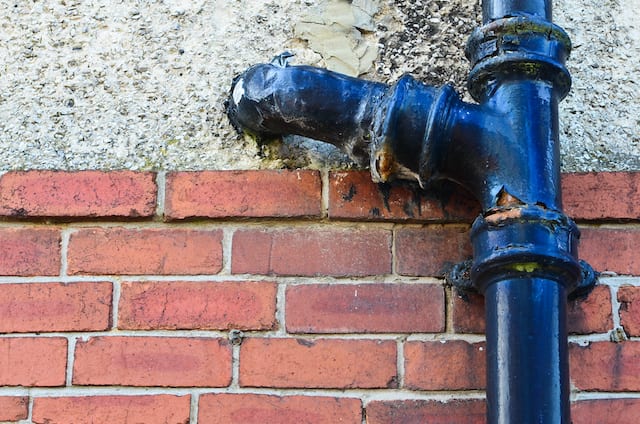Cast Iron Plumbing – The Advantages and Disadvantages
Cast iron plumbing has been around for decades, and we still manufacture it today. It is the old gold standard for drainpipes, and you can find them in many older homes’ systems. Newer homes are typically built with PVC or ABS piping as it’s cheaper, lighter-weight, and less prone to corrosion. Plus, they’re easier to repair, which is why we consider them the gold standard today.
If your home has cast iron plumbing, this is neither a good or bad thing. But depending on a few factors (particularly age), you need to be aware of a few things. Let’s talk about the advantages and disadvantages of cast iron plumbing!
What is Cast Iron Plumbing?
Sewer drainage, specifically DWV systems (Drain, Waste, and Vent), used cast iron pipes worldwide. You’ll typically find iron pipes in older homes built during or before the 1970s (early 1980s in some places).
Back then, builders favored cast iron pipes for the material’s durability, ability to handle water through them, and resist damage. Still, they are generally no longer installed in residential settings today.
Where is Cast Iron Piping Found?
The majority of homes built before 1975 were constructed with cast iron pipes in the plumbing system, although we still installed it into the early 1980s in some places. Yes, cast iron is a durable and strong material, but it has some drawbacks. The most common issue is that it deteriorates over time – often unseen from the pipe’s interior. This means you may not even know you have a problem until you have a sewer backup.
According to InterNACHI, the life expectancy of Cast Iron Waste Pipes in Florida is about 40-60 years, but every situation can vary. Some homeowners have even found that their cast iron begins to deteriorate after about 25-years. This means that many homes built with original cast iron piping systems may be starting to have plumbing/drainage issues today.
Disadvantages of Cast Iron Pipes
We preferred to use cast iron pipes for many years for their strength. However, homeowners and builders have begun to realize that they aren’t as durable for an extended period, and better materials are available today.
Over time, specific issues almost always pop up in homes built with cast iron plumbing systems.
Common Issues with Cast Iron Damage Include:
- Corrosion: This is almost always the first issue that will take place, often from the pipe’s interior that you can’t see.
- Cast iron is very heavy: This can lead to sinking in the ground and can cause cracking. It’s also harder to repair.
- Clogged and slow drains
- Sewer backup into homes: This can lead to:
- Water damage
- Unsanitary conditions
- Pest infestations
- Can allow mold to grow
- Expensive, messy repairs: You may even have to remove the slab in places to replace it. This is costly and messy. You could even be displaced from the home for a while in some cases.
- Insurance may not cover repairs: Be sure to check your homeowners’ policy for specific exclusions. In some cases, they may be required to fix the issue, but not always. Litigation seems to be ongoing about this issue.
Dangers of Cast Iron Pipes
Cast iron isn’t inherently dangerous. However, the connections/joints do often contain lead, which has known health concerns when consumed. Since these pipes aren’t used for drinking (i.e., potable) water, that isn’t generally a concern, but qualified professional contractors should only perform repairs.
Since cast iron is made of metal, hydrogen sulfide gas can create a chemical reaction between the waste and cast iron when the pipes have waste flowing through them. When the gas oxidizes, sulfuric acid is created and causes corrosion within the pipes. This results in the common rusting pipes from the inside out.
The main reason that the pipelines can become clogged is because of the rust. The rust flakes can gather, swell and form a block in the line’s flow. As this deteriorates the pipe wall, it can also invite tree roots to penetrate, further impacting the problem.
When sewage backs up into the home, this obviously invites unsanitary conditions that can be a health hazard. Not to mention damage to the property from moisture exposure. You must fix it at this point, and the fix can sometimes be expensive and quite messy.
Should I buy a home with Cast Iron Pipes?
Ultimately, we can’t provide you with a definitive “yes or no” take on this. We never try to steer buyers in the direction of buying a home or not. We simply aim to provide you facts about the home’s condition, but the individual choice must be your own.
However, know that in some places, it may be tough to avoid these pipes entirely (especially in localities with older housing stock). Our opinion is that cast iron pipes should not be an immediate deal-breaker. Just make sure you do your due diligence!
During your inspection period, have a licensed plumber scope these pipes to determine their interior condition. If they are damaged or heavily corroded, you (or the seller) should have them fixed or replaced. As home inspectors, we can’t see the pipe’s interior condition. So you will need to hire a plumber to “video scope” the interiors of the pipe to learn their true condition.
Advantages of Cast Iron Pipes
Although cast iron pipes deteriorate over time, the reality is that most older homes have at least some cast iron plumbing that is still intact. Cast iron pipes can actually last for over 100 hundred years in some cases! It all depends on the geographic location of the home and the pipes.
While homes with cast iron pipes laid in clay soil tend to be more likely to have corrosion, homes built in sandy soil often have pipes that last longer.
Cast iron is durable and strong. Many of the municipal pipelines and commercial buildings across the US still have cast iron pipes working just fine. Another big plus is they’re quiet!
Here’s one of our favorite builders to watch on YouTube, who actually installed them recently (as of 2021) in some places in his own home, for this very reason! However, they generally aren’t recommended to be installed anymore, especially with more reliable materials available.
What Do I Do if My Home has Cast Iron Plumbing?
First, you should determine if your home has cast iron plumbing. As a home inspector, we can assist with this. If it does, it is a good idea to have a qualified licensed plumber come out to your home for a deeper inspection of the piping system. Often they will video-scope them to determine the condition of the pipe interior.
If the plumber determines that your pipes are still in good condition and working properly, then you don’t need to worry about making a change right away. However, you should take note of this and make sure to have a plumber come out every year or so to re-assess the condition of your pipes. Also, check your homeowners’ insurance policy for any exclusions on drain piping, sewer backups, etc., and you may even consider budgeting today for future repairs that may be needed on a “rainy day.”
If your pipes are starting to deteriorate, you’ll want to look into having the sections that are damaged replaced sooner rather than later. An alternative to replacement is known as trenchless pipe repair. This is where they reline the pipes with an epoxy-based material that makes them smooth and good as new. This is definitely better than having your slab cracked open, but the old pipes have to still have some degree of integrity to them, so don’t wait too long if you want this done.
Damaged pipes can result in messy, unsanitary, and costly repairs if they are not repaired, so you’ll save more money in the long run by being proactive!






